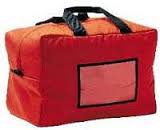 If you are going to cruise offshore on your sailboat, you will need among its emergency equipment an abandon ship bag, also called a ditch or grab bag. Never assume that you will be safe close to shore either because wind or current might carry you in a liferaft or dinghy away from a possible rescue area. Even if you have communication gear, never assume that rescue will come before you would need your grab bag. Life rafts typically have only minimal gear because of space and weight limitations, so make sure that your grab bag is well stocked for your personal needs. Before getting into the life raft, grab your passports / licenses in ziplock bags, wet weather gear and life jackets or PFD’s.
If you are going to cruise offshore on your sailboat, you will need among its emergency equipment an abandon ship bag, also called a ditch or grab bag. Never assume that you will be safe close to shore either because wind or current might carry you in a liferaft or dinghy away from a possible rescue area. Even if you have communication gear, never assume that rescue will come before you would need your grab bag. Life rafts typically have only minimal gear because of space and weight limitations, so make sure that your grab bag is well stocked for your personal needs. Before getting into the life raft, grab your passports / licenses in ziplock bags, wet weather gear and life jackets or PFD’s.
The Bag (or airtight bottle in our case)
Commercially available bags are relatively inexpensive and usually the best way to ensure the bag has all the right characteristics like positive flotation, being waterproof, has visible reflective strips, is of sufficient size, and a long lanyard is secured to the handles. When you have to throw it overboard, you will need to secure it to the life raft or yourself so as not to loose it.
Rescue Items
- Functioning, registered 406 EPIRB (emergency position-indicating rescue beacon) to inform rescuers of your location
- Handheld VHF radio (waterproof or in sealed pouch, with extra batteries).
- Selection of emergency flares (parachute and handheld) and smoke signals.
- Strobe light (may be present in inflatable PFD);
- Flashlight & batteries
- Whistle
- Signal mirror
Survival Items
- Water – individually sealed emergency water packets or we have 5 Gallon jug of water tied to the grab bag, ready to be deployed. This is the single most important thing you will take.
- Emergency food rations (commercially available sealed high-calorie bars formulated to decrease thirst)
- Can opener if canned food as well as a leatherman tool
- Essential prescribed medications
- First aid kit
- Hand-operated desalinating watermaker
- Hand held compass
- Patch kit for inflatable dinghy or liferaft
- Knife
- Matches
- Handheld GPS (to communicate position by VHF or cell phone)
- Solar blanket
- Fishing gear (hand line, jigs, hooks)
- Sunscreen, hats, long sleeve rash guards, polarized sunglasses
- Bailer
- Small pair of binoculars
In Conclusion
Check your grab bag at least once a year and always before a long passage and make sure that all your crew knows where it will be stowed. Look for expired flares and any tears in water or food packets. Replace batteries. Remember, you are safer in the big boat even if half filled with water and your chances of being found on the big boat is much greater than on a dinghy or life raft. Do not panic and abandon ship before absolutely neccessary.
Finally, before leaving on a passage, make sure that your crew knows their roles in emergency situations. Each one should know what to do or grab. While the liferaft is being launched, someone can grab the ditch bag, others can grab additional water jugs, more flares, the ship’s larger first aid kit, a prepared pouch of the ship’s documents and passports, etc.





